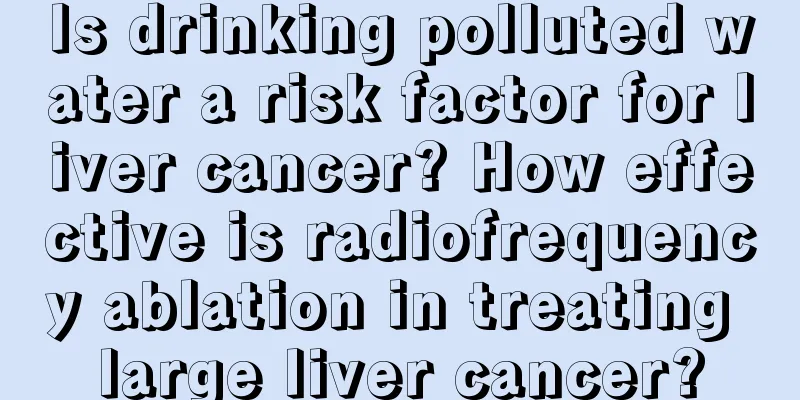Is drinking polluted water a risk factor for liver cancer? How effective is radiofrequency ablation in treating large liver cancer?

|
Is drinking polluted water a risk factor for liver cancer? As early as the 1970s, medical workers in my country discovered that in areas with a high incidence of liver cancer, the incidence of liver cancer is closely related to the source of drinking water. Data show that in my country's high-incidence areas of liver cancer, residents who drink ditch and pond water have the highest incidence and mortality rates of liver cancer, followed by those who drink river water, and those who drink deep well water have the lowest. This fully proves that drinking water pollution is related to the incidence and mortality rates of liver cancer. For example, in Qidong County, Jiangsu Province, Nanhui County, Shanghai, Fusui County, Guangdong Province and other places, the mortality rate of liver cancer patients who drank surface water was significantly higher than that of those who drank well water. Through the analysis of ditch and pond water, it was found that there are more than 100 carcinogenic or cancer-promoting substances in the water, such as hexachlorobenzene, benzopyrene, polychlorinated biphenyls, etc., which have carcinogenic effects. It was also found that cyanobacteria often breed in ditch and pond water, and green algae can produce microcystin, which is highly toxic to the liver and can cause damage and necrosis of liver cells. It is a strong cancer promoter. Water pollution is mostly caused by the indiscriminate construction of factories for industrial development, but no pollution reduction measures are taken, which eventually harms nearby residents. Residents can raise funds to dig deep wells. Deep well water is generally less polluted. If there are no conditions to dig a deep well, you can drink water that has been purified by the water plant. At the same time, you cannot drink raw water and must boil it before drinking. Radiofrequency ablation is effective in treating large liver cancer Large liver cancer has distinct clinical characteristics, namely, it is often accompanied by surrounding satellite lesions, portal vein branch thrombosis and even intrahepatic and extrahepatic metastasis. The range of the cancer lesions is large, much larger than the range of lesions shown by CT or MRI. It is often accompanied by varying degrees of viral hepatitis and cirrhosis, and the liver function reserve is poor. Due to years of liver disease treatment, the patient's family financial situation is often not strong. The treatment of large liver cancer is not as easy as that of early liver cancer. Because when large liver cancer is removed, a larger area of normal liver tissue needs to be removed, which has a greater impact on liver function and a high incidence of complications. More importantly, only about 10% of patients with large liver cancer are suitable for liver resection. Transarterial chemoembolization can control the volume of liver cancer to a certain extent, but it also promotes the metastasis of cells around the cancer. It is difficult to obtain satisfactory therapeutic effects by using it alone; other drug treatments including immunotherapy and targeted drugs are difficult to achieve significant therapeutic effects. Radiofrequency ablation is a new technology for the treatment of liver cancer that has been developed in the past decade. Its principle is to use radiofrequency current to make the ions in the cancer tissue oscillate at high speed, generate a temperature of about 105°C, and destroy the cancer tissue. Radiofrequency ablation has now become one of the curative means for early liver cancer. It can be used as the first choice for the treatment of early liver cancer and plays an increasingly important role in the comprehensive treatment of liver cancer. In the past five years, radiofrequency ablation has been increasingly used in the comprehensive treatment of liver cancer, experience has gradually accumulated, and radiofrequency ablation equipment has been significantly improved. More importantly, people's understanding of liver cancer has become more in-depth and systematic. All of these have laid the foundation for the use of radiofrequency ablation in the treatment of large liver cancer, so that some carefully selected large liver cancers have achieved satisfactory results through comprehensive treatment with radiofrequency ablation as the main treatment. In addition, this technology has a definite therapeutic effect on liver cancer, and has the advantages of simple operation, minimal trauma, low requirements for liver function, and low cost, making it easily accepted by patients. |
>>: What are the three common liver cancer treatment methods?
Recommend
What exercises can patients with pituitary tumors do
Nowadays, more and more people are pursuing a spo...
What to do if your lips are dry and itchy?
Dry and itchy lips are a common condition for us....
Tie clip position
With the development of modernization, people'...
What is the degree of pseudomyopia? Timely diagnosis is very important
If children or teenagers develop myopia, it is of...
Is it better to use a pregnancy test stick or a pregnancy test paper?
I don’t know whether I am pregnant or not. It’s t...
What causes liver cancer? 4 reasons tell you how liver cancer is formed
As we all know, in life, any word related to &quo...
What to do if a stone is stuck in the urethra
If a person does not pay attention to his or her ...
Nursing for right endometrial cancer
The psychological care of patients with endometri...
Is it okay to always use makeup remover oil if there are red blood streaks on the face?
Everyone's skin is different. Some people hav...
What should I do if my tooth is broken in half?
The phenomenon of a tooth being broken in half is...
Why is my urine yellow in the morning?
Many people find that their urine is very yellow ...
Can I drink green tea if I have chronic gastritis?
The treatment of chronic gastritis takes time, an...
What are the causes of lung disease
The lungs are an important organ in the human bod...
How to preserve the fragrance of osmanthus?
The sweet osmanthus is fragrant in August. Sweet ...
Why do I feel sore all over?
Many people have experienced body aches in their ...









